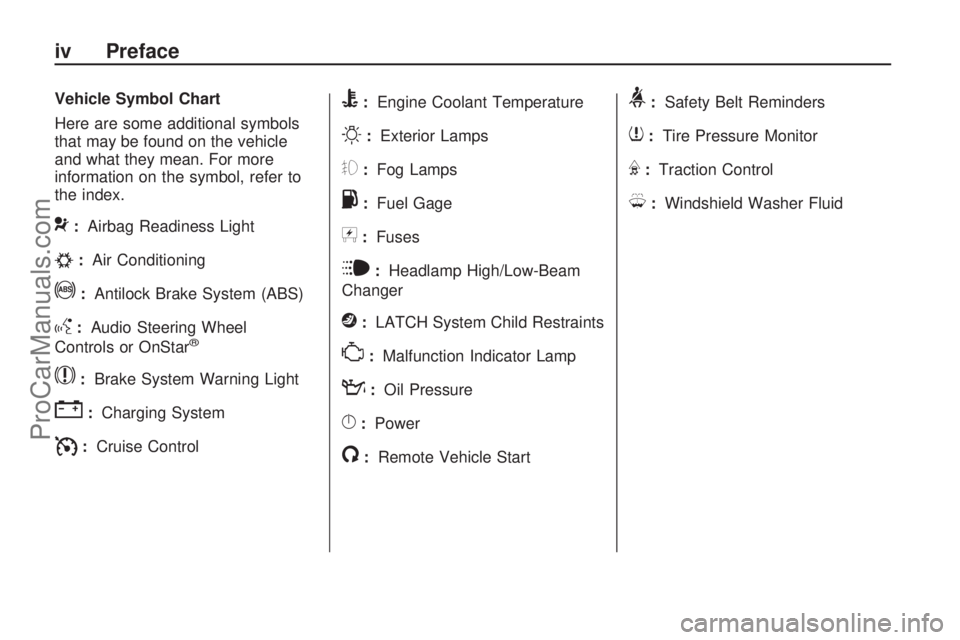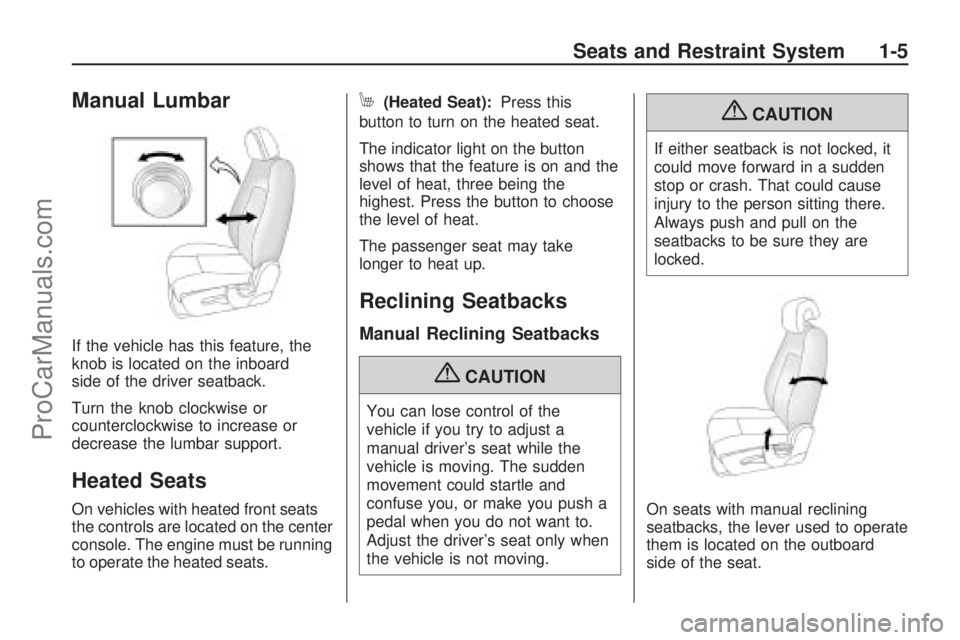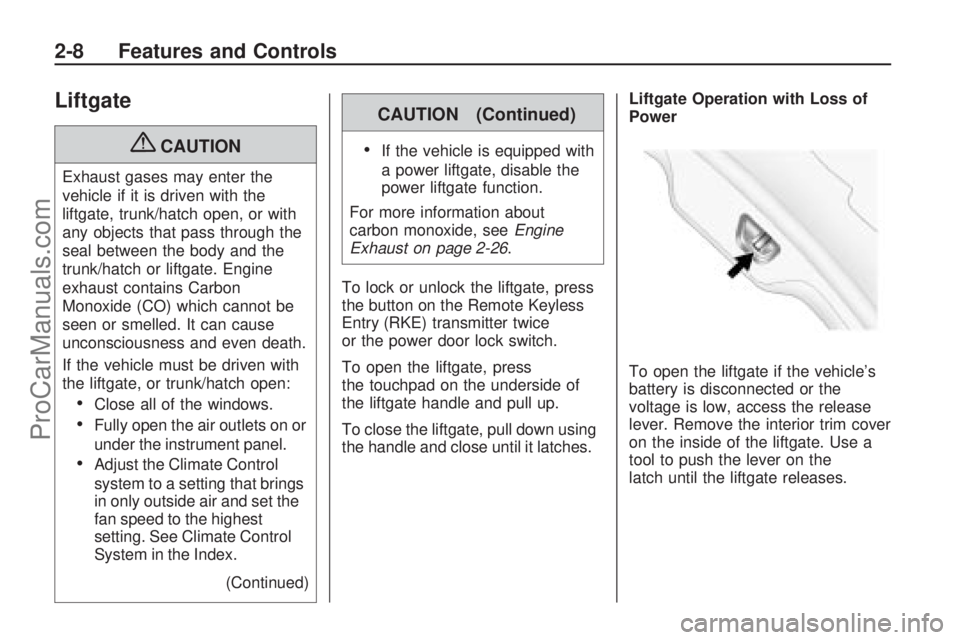engine SATURN VUE HYBRID 2009 Owners Manual
[x] Cancel search | Manufacturer: SATURN, Model Year: 2009, Model line: VUE HYBRID, Model: SATURN VUE HYBRID 2009Pages: 346, PDF Size: 2.1 MB
Page 4 of 346

Vehicle Symbol Chart
Here are some additional symbols
that may be found on the vehicle
and what they mean. For more
information on the symbol, refer to
the index.
9:Airbag Readiness Light
#:Air Conditioning
!:Antilock Brake System (ABS)
g:Audio Steering Wheel
Controls or OnStar®
$:Brake System Warning Light
":Charging System
I:Cruise Control
B:Engine Coolant Temperature
O:Exterior Lamps
#:Fog Lamps
.:Fuel Gage
+:Fuses
i:Headlamp High/Low-Beam
Changer
j:LATCH System Child Restraints
*:Malfunction Indicator Lamp
::Oil Pressure
}:Power
/:Remote Vehicle Start
>:Safety Belt Reminders
7:Tire Pressure Monitor
F:Traction Control
M:Windshield Washer Fluid
iv Preface
ProCarManuals.com
Page 9 of 346

Manual Lumbar
If the vehicle has this feature, the
knob is located on the inboard
side of the driver seatback.
Turn the knob clockwise or
counterclockwise to increase or
decrease the lumbar support.
Heated Seats
On vehicles with heated front seats
the controls are located on the center
console. The engine must be running
to operate the heated seats.
M(Heated Seat):Press this
button to turn on the heated seat.
The indicator light on the button
shows that the feature is on and the
level of heat, three being the
highest. Press the button to choose
the level of heat.
The passenger seat may take
longer to heat up.
Reclining Seatbacks
Manual Reclining Seatbacks
{CAUTION
You can lose control of the
vehicle if you try to adjust a
manual driver’s seat while the
vehicle is moving. The sudden
movement could startle and
confuse you, or make you push a
pedal when you do not want to.
Adjust the driver’s seat only when
the vehicle is not moving.
{CAUTION
If either seatback is not locked, it
could move forward in a sudden
stop or crash. That could cause
injury to the person sitting there.
Always push and pull on the
seatbacks to be sure they are
locked.
On seats with manual reclining
seatbacks, the lever used to operate
them is located on the outboard
side of the seat.
Seats and Restraint System 1-5
ProCarManuals.com
Page 63 of 346

Features and
Controls
Keys
Keys...................................2-2
Remote Keyless Entry
(RKE) System...................2-3
Remote Keyless Entry
(RKE) System Operation. . .2-4
Doors and Locks
Door Locks.........................2-6
Power Door Locks..............2-6
Delayed Locking.................2-6
Automatic Door Lock..........2-7
Automatic Door Unlock.......2-7
Rear Door Security
Locks................................2-7
Lockout Protection..............2-7
Liftgate...............................2-8
Windows
Windows.............................2-9
Power Windows..................2-9
Sun Visors........................2-10
Theft-Deterrent Systems
Theft-Deterrent Systems. . . .2-10
Content Theft-Deterrent.....2-10
PASS-Key®III+ Electronic
Immobilizer......................2-12
PASS-Key®III+ Electronic
Immobilizer Operation......2-12
Starting and Operating
Your Vehicle
New Vehicle Break-In.......2-14
Ignition Positions...............2-14
Retained Accessory
Power (RAP)...................2-15
Starting the Engine
(Automatic Engine
Start/Stop)
.......................2-15
Engine Coolant Heater......2-19
Automatic Transmission
Operation........................2-20
Parking Brake...................2-22
Regenerative Braking........2-23
Shifting Into Park..............2-23
Shifting Out of Park..........2-25
Parking Over Things
That Burn........................2-25
Engine Exhaust.................2-26
Running the Vehicle
While Parked..................2-26
Mirrors
Manual Rearview Mirror. . . .2-27
Automatic Dimming
Rearview Mirror...............2-27
Outside Power Mirrors......2-28
Outside Convex Mirror......2-28
Outside Heated Mirrors.....2-28
OnStar®System
OnStar®System................2-29
Universal Home Remote
System
Universal Home Remote
System............................2-32
Universal Home Remote
System Operation............2-33
Features and Controls 2-1
ProCarManuals.com
Page 70 of 346

Liftgate
{CAUTION
Exhaust gases may enter the
vehicle if it is driven with the
liftgate, trunk/hatch open, or with
any objects that pass through the
seal between the body and the
trunk/hatch or liftgate. Engine
exhaust contains Carbon
Monoxide (CO) which cannot be
seen or smelled. It can cause
unconsciousness and even death.
If the vehicle must be driven with
the liftgate, or trunk/hatch open:
Close all of the windows.
Fully open the air outlets on or
under the instrument panel.
Adjust the Climate Control
system to a setting that brings
in only outside air and set the
fan speed to the highest
setting. See Climate Control
System in the Index.
(Continued)
CAUTION (Continued)
If the vehicle is equipped with
a power liftgate, disable the
power liftgate function.
For more information about
carbon monoxide, seeEngine
Exhaust on page 2-26.
To lock or unlock the liftgate, press
the button on the Remote Keyless
Entry (RKE) transmitter twice
or the power door lock switch.
To open the liftgate, press
the touchpad on the underside of
the liftgate handle and pull up.
To close the liftgate, pull down using
the handle and close until it latches.Liftgate Operation with Loss of
Power
To open the liftgate if the vehicle’s
battery is disconnected or the
voltage is low, access the release
lever. Remove the interior trim cover
on the inside of the liftgate. Use a
tool to push the lever on the
latch until the liftgate releases.
2-8 Features and Controls
ProCarManuals.com
Page 75 of 346

When trying to start the vehicle if
the engine does not start and
the security light on the instrument
panel cluster comes on, there
may be a problem with your
theft-deterrent system. Turn the
ignition off and try again.
If the engine still does not start,
and the key appears to be not
damaged, wait about �ve minutes
and try another ignition key and
check the fuse. SeeFuses
and Circuit Breakers on page 5-75.
If the engine still does not start
with the other key, the vehicle
needs service. If the vehicle does
start, the �rst key may be faulty.
See your dealer/retailer who
can service the PASS-Key
®III+
to have a new key made. In
an emergency, contact Roadside
Assistance. SeeRoadside
Assistance Program on page 7-5.It is possible for the PASS-Key
®III+
decoder to “learn” the transponder
value of a new or replacement key.
Up to 10 keys may be programmed
for the vehicle. The following
procedure is for programming
additional keys only. If all the
currently programmed keys are
lost or do not operate, you must see
your dealer/retailer or a locksmith
who can service PASS-Key
®III+
to have keys made and programmed
to the system.
See your dealer/retailer or a
locksmith who can service
PASS-Key
®III+ to get a new key
blank that is cut exactly as the
ignition key that operates the system.
To program the new key:
1. Verify that the new key has
a
1stamped on it.
2. Insert the already programmed
key in the ignition and start the
engine. If the engine does not
start, see your dealer/retailer
for service.3. After the engine has started, turn
the key to LOCK/OFF, and
remove the key.
4. Insert the key to be programmed
and turn it to the ON/RUN
position within �ve seconds of
the original key being turned
to the LOCK/OFF position.
The security light turns off once
the key has been programmed.
5. Repeat Steps 1 through 4
if additional keys are to be
programmed.
If the PASS-Key
®III+ key is lost or
damaged, see your dealer/retailer
or a locksmith to have a new
key made.
Do not leave the key or device that
disarms or deactivates the theft
deterrent system in the vehicle.
Features and Controls 2-13
ProCarManuals.com
Page 76 of 346

Starting and
Operating Your
Vehicle
New Vehicle Break-In
Notice:The vehicle does
not need an elaborate break-in.
But it will perform better in
the long run if you follow these
guidelines:
Do not drive at any one
constant speed, fast or slow,
for the �rst 500 miles (805 km).
Do not make full-throttle
starts. Avoid downshifting to
brake or slow the vehicle.
Avoid making hard stops for
the �rst 200 miles (322 km)
or so. During this time the
new brake linings are not yet
broken in. Hard stops with new
linings can mean premature
wear and earlier replacement.
Follow this breaking-in
guideline every time you
get new brake linings.
Do not tow a trailer during
break-in. SeeTowing a
Trailer on page 4-26for the
trailer towing capabilities
of your vehicle and more
information.
Following break-in, engine speed
and load can be gradually
increased.
Ignition Positions
The ignition switch has four different
positions.To shift out of P (Park), turn the
ignition to ON/RUN and apply
the regular brake pedal.
Notice:Using a tool to force the
key to turn in the ignition could
cause damage to the switch
or break the key. Use the correct
key, make sure it is all the
way in, and turn it only with
your hand. If the key cannot be
turned by hand, see your
dealer/retailer.
LOCK/OFF:This position locks the
ignition. It also locks the steering
wheel and the transmission. The key
can only be removed in LOCK/OFF.
The shift lever must be in P (Park) to
turn the ignition switch to LOCK/OFF.
The steering can bind with the
wheels turned off center. If this
happens, move the steering wheel
from right to left while turning the key
to ACC/ACCESSORY. If this doesn’t
work, the vehicle needs service.
2-14 Features and Controls
ProCarManuals.com
Page 77 of 346

ACC (ACC/ACCESSORY):This is
the position in which you can operate
the electrical accessories or items
plugged into the accessory power
outlets.
Use this position if the vehicle must
be pushed or towed.
ON/RUN:This position can be used
to operate the electrical accessories
and to display some instrument
panel cluster warning and indicator
lights. The switch stays in this
position when the engine is running.
The transmission is also unlocked in
this position. If you leave the key in
the ACC/ACCESSORY or ON/RUN
positions with the engine off, the
battery could be drained. You may
not be able to start the vehicle if the
battery is allowed to drain for an
extended period of time.START:This is the position that
starts the engine. When the engine
starts, release the key. The ignition
switch returns to ON/RUN for driving.
A warning tone will sound when the
driver door is opened, the ignition is
in ACC/ACCESSORY or LOCK/OFF
and the key is in the ignition.
Retained Accessory
Power (RAP)
These vehicle accessories may be
used for up to 10 minutes after
the ignition key is turned off:
Outside Mirror
Power Windows
Radio
All these features work when the
ignition key is in the ON/RUN
or ACC/ACCESSORY positions,
until a door is opened.
Starting the Engine
(Automatic Engine
Start/Stop)
Place the transmission in the
proper gear.
Move the shift lever to P (Park) or
N (Neutral). The engine will not start
in any other position. To restart the
engine when the vehicle is already
moving, use N (Neutral) only.
Notice:Do not try to shift to
P (Park) if the vehicle is moving.
If you do, you could damage
the transmission. Shift to P (Park)
only when the vehicle is stopped.
Starting Procedure
1. With your foot off the accelerator
pedal, turn the ignition key to
START. When the engine starts,
let go of the key. The idle speed
will go down as your engine gets
warm. Do not race the engine
immediately after starting it.
Features and Controls 2-15
ProCarManuals.com
Page 78 of 346

Operate the engine and
transmission gently to allow the
oil to warm up and lubricate all
moving parts.
The vehicle has a
Computer-Controlled Cranking
System. This feature assists in
starting the engine and protects
components. If the ignition key is
turned to the START position,
and then released when the
engine begins cranking, the
engine will continue cranking for a
few seconds or until the vehicle
starts. If the engine does not start
and the key is held in START,
cranking stops after 15 seconds
to prevent cranking motor
damage. To prevent gear
damage, this system also
prevents cranking if the engine is
already running. Engine cranking
can be stopped by turning the
ignition switch to the ACC/
ACCESSORY or LOCK/OFF
position.Notice:Cranking the engine for
long periods of time, by returning
the key to the START position
immediately after cranking has
ended, can overheat and damage
the cranking motor, and drain the
battery. Wait at least 15 seconds
between each try, to let the
cranking motor cool down.
2. If the engine does not start after
5-10 seconds, especially in
very cold weather (below 0°F
or−18°C), it could be �ooded with
too much gasoline. Try pushing
the accelerator pedal all the way
to the �oor and holding it there as
you hold the key in START for a
maximum of 15 seconds. Wait at
least 15 seconds between each
try, to allow the cranking motor to
cool down. When the engine
starts, let go of the key andaccelerator. If the vehicle starts
brie�y but then stops again,
repeat the procedure. This clears
the extra gasoline from the
engine. Do not race the engine
immediately after starting it.
Operate the engine and
transmission gently until the oil
warms up and lubricates all
moving parts.
Notice:Your engine is designed
to work with the electronics in
your vehicle. If you add electrical
parts or accessories, you could
change the way the engine
operates. Before adding electrical
equipment, check with your
dealer/retailer. If you do not,
your engine might not perform
properly. Any resulting damage
would not be covered by your
vehicle’s warranty.
2-16 Features and Controls
ProCarManuals.com
Page 79 of 346

Automatic Engine Start/Stop
{CAUTION
There is something about the
vehicle that can make it move
suddenly, and you or others can
be seriously injured. This can
happen if the vehicle is in the
Auto Stop mode, and the shift
lever is in D (Drive). Because the
vehicle has the Automatic Engine
Start/Stop feature, the vehicle’s
engine might seem to be shut off
when you come to a complete
stop. However, if you then start to
exit the vehicle, as soon as you
take your foot off the brake pedal,
the engine will start again and the
vehicle can move forward. If you
are going to exit the vehicle,
�rst shift to P (Park) and turn the
ignition to LOCK/OFF. Then exit.The vehicle has an automatic
engine start/stop feature that is
a part of the hybrid system. After the
engine is started and has reached
operating temperature, the AUTO
STOP feature may turn the
engine off when you apply the
brakes and come to a complete
stop. When you take your foot
off the brake pedal or press the
accelerator pedal, the engine
will start. The engine will continue
to run until the next AUTO STOP.
The AUTO STOP mark on the
tachometer indicates that the engine
is in AUTO STOP mode. If the
driver door is opened while in AUTO
STOP mode, a chime will sound.If you are on an incline, the vehicle
may roll backwards a short distance
until the engine performs an AUTO
START. The Hill Start Assist feature
will help start the vehicle on a
moderate or steep incline. To restart
the engine during the AUTO STOP,
release the brake pedal or press the
accelerator pedal. The engine starts
immediately. The vehicle continues
to run until the next stop.
There are several conditions that
may prevent an AUTO STOP
or cause an AUTO START.
Features and Controls 2-17
ProCarManuals.com
Page 80 of 346

The Engine Will Remain
Running When:
The engine, transmission, or
hybrid battery is not warmed
up yet.
The outside temperature is
high — usually above
95°F (35°C) and the climate
control system is working to
cool the vehicle in A/C mode
(yellow light illuminated on
A/C button) or if defrost is
selected. SeeAutomatic Climate
Control System on page 3-17
for more information.
The shift lever is in P (Park),
R (Reverse), N (Neutral) or
M (Manual Mode).
The hybrid battery pack
charge is low.
The 12V vehicle battery charge
is low, or loads are high.
The hood is not fully closed.The Engine Will Restart When:
The brake pedal is released.
The accelerator pedal is applied.
When shifting from D (Drive)
to P (Park), R (Reverse),
N (Neutral) or M (Manual Mode),
the engine will restart
immediately.
If the A/C button (green light
illuminated on A/C) button is
selected, the duration of
the AUTO STOP will depend on
the outside temperature. This
economy mode improves
fuel economy by limiting the
effects of the air conditioning.
The warmer it is outside,
the shorter the time before the
engine is restarted to provide
cabin cooling.
The climate control system is
turned from Off to On (econ
or normal A/C, or �oor/
defog/defrost) SeeAutomatic
Climate Control System on
page 3-17for more information.
The engine is required to run for
either heater or climate control
performance. See “Air
Conditioning and Engine
Start/Stop” underAutomatic
Climate Control System on
page 3-17for more information.
The hybrid battery pack charge is
low and requires recharging.
Auto Stop time is greater than
two minutes.
2-18 Features and Controls
ProCarManuals.com